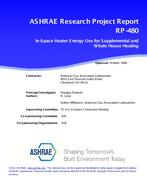Description
In a centrally heated home using a warm air furnace or boiler, one technique for saving energy is to exclude or control heat for certain areas. This results in uncomfortable areas of the home. A technique resulting in more overall comfort is to provide a source of supplemental heat to those areas being occupied (at the time) and exclude or lower the overall supply of central heat. The work discussed in this paper was aimed at quantifying the potential energy savings of using gas-fired in-space heaters (heaters) as supplemental heaters, and when using the heaters as the sole source of heat for the home. Data are presented for gas-fired unvented, vented (radiant), vented (convective) and direct-vent heaters installed in two test homes in Cleveland, Ohio. One home represented a circa 1950″s bungalow with minimal insulation and the other a modern, energy conservation 1984 condominium. Room-to-room temperature, outdoor temperature, thermostat temperature, energy consumption (both gas and electric) and heater cycles were measured. All heaters were installed strictly according to the manufacturers instructions, and in enough capacity to heat the whole house. Two-week long tests were conducted and compared to results for the central heating system. Results showed that the in-space heaters used less energy than the central system; about 28% less in the 1950’s house, and about 34% less in the modern house. Further, less electrical energy was used by the heaters. The in-space heater scheme had larger room-to-room temperature gradient, and the data collected appears to provide heater sizing information that can be used in the ASHRAE Handbook.
Product Details
- Published:
- 1988
- Number of Pages:
- 48
- File Size:
- 1 file , 1.2 MB
- Product Code(s):
- D-RP-480




